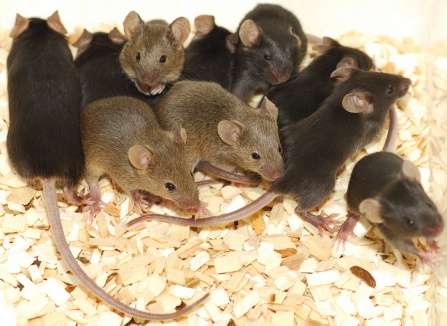The more the merrier for animals that synchronize their behavior

Social interaction could be the mechanism that allows animals living in groups to synchronize their activities, whether it's huddling for warmth or offering protection from predators.
This social presence affects the daily rhythm of activity and rest, and the larger the group, the greater the likelihood of synchronization, according to a study published recently in the journal Biology Letters.
"At least in mice, and perhaps in other animals, this study shows quite dramatic synchrony amongst groups of animals that can only be explained by social interactions," said University at Buffalo psychologist Matthew Paul, lead author of the study with Premananda Indic and William Schwartz of the University of Massachusetts Medical School.
All animals have daily rhythms, sometimes called circadian rhythms, a term derived from Latin, meaning "around a day." At one time these rhythms were thought to be generated by a direct response to the daily cycle of lightness and darkness. But even without light or other external cues, most animals still have a 24-hour rhythm.
In the absence of external cues, something internal must be regulating these rhythms, according to Paul.
Most studies examining how animals time their behaviors have used only animals living alone, and it has been assumed that species members synchronized to a common external cue.
However, social regulation of circadian clocks is another possibility. The trend was present in previous experiments, but the results were mixed.
"We took the view that it was necessary to find out what the rules might be that govern social influences on these clocks," said Paul. "If these social interactions do influence our clocks, then knowing the rules would help us understand how that works."
Paul says one possible rule is that social synchronization requires larger numbers of animals, and the likelihood of synchronization increases as the size of the group increases.
"The answers to the question of whether social interactions can affect our biological clocks - can cause synchrony - have been spotty in the past perhaps in part because the experiments didn't use enough animals living together."
The researchers determined synchrony by measuring the body temperature rhythms of the mice. The study didn't go into detail to determine if, for example, all the mice were eating at the same time, but Paul says the overall implication is that their general activities are synchronized.
"This experiment suggests that living in groups can affect our rhythms, but we still need to know more." said Paul "In order to remove external cues we did this experiment in constant darkness, an environment that mice prefer."
"The next question is what happens in the light-dark cycle? That cycle synchronizes us in general, but now we have another force that's affecting our clock and we can learn how these two forces act together. Once we find that out we will know more about the effects of animals, and perhaps even humans, living in groups and those living alone."
Journal information: Biology Letters
Provided by University at Buffalo




















